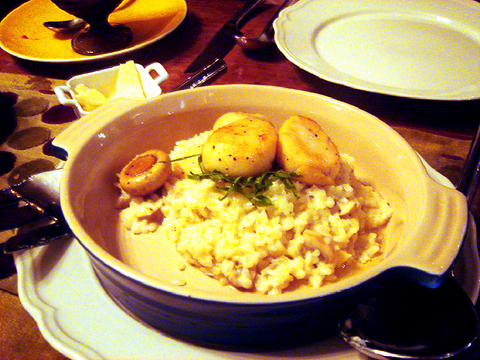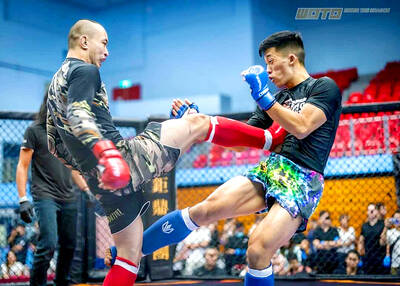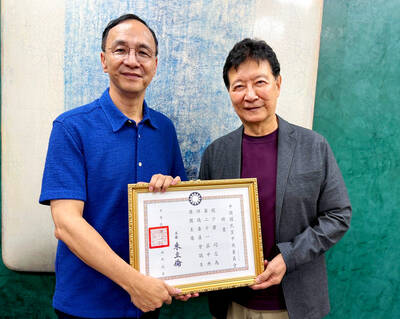The Taipei Times has twice reviewed VVG (Very Very Good) Bistro, of which VVG Table is a down-the-street offshoot. It was good then, and it remains good now. The original's cozy chaos contracts strongly with the design-conscious good-looks of the new joint.
The staff members, many of whom have studied in Europe, eschews a practice common to European-style restaurants in Taipei, which might generously be called "fusion." This is to say, instead of castrating their food to make it "conform to local taste," they spend considerable time and energy to do each dish properly.
In fact, be prepared to wait a bit for your food, because chances are that most of your order is going to be made from scratch. Past the semi-open porch and the rusticlassy wooden interior full of heavy wooden tables and an entire wall of wine, there is a beautiful open kitchen where you can see the chefs' heads bobbing over piles of fresh ingredients.

PHOTO: CHRIS PECHSTEDT, TAIPEI TIMES
The same thoughtfulness that goes into preparation and decoration goes into the menu. As I indiscreetly cast longing glances at my pumpkin soup (NT$180) and rocket salad with prosciutto, capsicum, and parmesan (NT$340), chef Vicky Huang (
The long prep-time for the main dishes makes it the sort of place where couples or larger groups with time to kill and money to burn can easily spend a long and comfortable summer evening.
Another big draw is the elaborate weekend brunch (NT$560, 11am to 4pm). This includes, but is not limited to, homemade bread, roast smoked salmon, chicken and zucchini skewers, and a dish described as "egg cups of crab and shrimp with quail egg and caviar." Cool drinks are served at strategic points through the meal, which ends with desert and cafe au lait or peppermint tea.
VVG Table is in a quiet maze of alleyways off the Zhongxiao-Dunhua intersection. It's not easy to find, but since it's made somewhat of a name for itself, most shopkeepers in the area should be able to provide directions.

Late last month Philippines Foreign Affairs Secretary Theresa Lazaro told the Philippine Senate that the nation has sufficient funds to evacuate the nearly 170,000 Filipino residents in Taiwan, 84 percent of whom are migrant workers, in the event of war. Agencies have been exploring evacuation scenarios since early this year, she said. She also observed that since the Philippines has only limited ships, the government is consulting security agencies for alternatives. Filipinos are a distant third in overall migrant worker population. Indonesia has over 248,000 workers, followed by roughly 240,000 Vietnamese. It should be noted that there are another 170,000

Enter the Dragon 13 will bring Taiwan’s first taste of Dirty Boxing Sunday at Taipei Gymnasium, one highlight of a mixed-rules card blending new formats with traditional MMA. The undercard starts at 10:30am, with the main card beginning at 4pm. Tickets are NT$1,200. Dirty Boxing is a US-born ruleset popularized by fighters Mike Perry and Jon Jones as an alternative to boxing. The format has gained traction overseas, with its inaugural championship streamed free to millions on YouTube, Facebook and Instagram. Taiwan’s version allows punches and elbows with clinch striking, but bans kicks, knees and takedowns. The rules are stricter than the

“Far from being a rock or island … it turns out that the best metaphor to describe the human body is ‘sponge.’ We’re permeable,” write Rick Smith and Bruce Lourie in their book Slow Death By Rubber Duck: The Secret Danger of Everyday Things. While the permeability of our cells is key to being alive, it also means we absorb more potentially harmful substances than we realize. Studies have found a number of chemical residues in human breast milk, urine and water systems. Many of them are endocrine disruptors, which can interfere with the body’s natural hormones. “They can mimic, block

Next week, candidates will officially register to run for chair of the Chinese Nationalist Party (KMT). By the end of Friday, we will know who has registered for the Oct. 18 election. The number of declared candidates has been fluctuating daily. Some candidates registering may be disqualified, so the final list may be in flux for weeks. The list of likely candidates ranges from deep blue to deeper blue to deepest blue, bordering on red (pro-Chinese Communist Party, CCP). Unless current Chairman Eric Chu (朱立倫) can be convinced to run for re-election, the party looks likely to shift towards more hardline